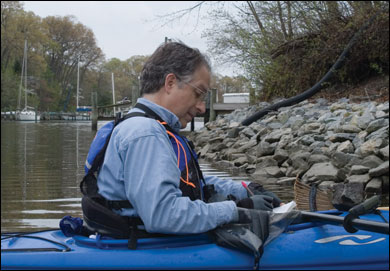Mussel Power
Can It Help
Clean The Bay?
Contents
Collateral Damage We Can't Afford
Sampling Life at the
Bottom of the Bay
Clear Water through Clam Culture?
Performance Honors
Rachel Carson's Life & Work
As Peter Bergstrom wades into Old Man Creek, he's grateful he's wearing neoprene socks. Calf-deep in the chilly water of early spring, he floats his blue kayak just past the ramp at Stewart's Landing in Severna Park, Maryland and climbs in carefully, tucking his slight frame into the hull. The riskiest time for capsizing is getting in.
Bergstrom paddles into the creek, wending his way along a coastline packed with houses, their narrow backyard docks jutting into the water. The tide is on the ebb and already the water level is low enough to expose the wooden pilings beneath the piers. Bergstrom maneuvers his kayak next to a piling, reaches into the water, and runs his hand down the pole.
In 2004 just a faint touch of Bergstrom's fingers on the piling would have sent strange little bivalves cascading to the creek's silty bottom. That summer the dark false mussel, as mysterious as its name, grew thick in Old Man Creek, a tributary off the Magothy River near Annapolis. Mussels clung like heavy carpets to almost every hard surface. They would tumble off under their own weight.
Now as Bergstrom drifts from piling to piling, he comes up empty-handed, feeling only a few rough-edged barnacles. He's not surprised the mussels are gone. A biologist for the National Oceanic and Atmospheric Administration (NOAA), Bergstrom has served 16 years as the volunteer monitoring coordinator for the Magothy River Association. And he had never before seen the likes of what happened in the summer of 2004, when hundreds of millions of these creatures found a temporary home in creeks of the Magothy, South, and Severn rivers.
Bergstrom thinks that the dark false mussels rode in on the coattails of Hurricane Isabel in late 2003, their larvae catching a plume of water that moved up from the saltier mid-Bay, where these creatures tend to live among oyster reefs. Finding their surroundings suitable, they settled on any hard surface they could find — pilings, riprap, the hulls of boats. And they ate. And ate.
The dark false mussel proved its punch as a powerful filter feeder that summer. Native to the Chesapeake and a close relative of the zebra mussel, the dark false mussel at its peak abundance was estimated to filter nearby Cattail Creek in just under two days.
The mussels ate algae and the waters of Old Man Creek cleared. In 2004 the creek measured the clearest it had ever been since Bergstrom started monitoring there in 1991. Fewer solid particles (total suspended solids) clouded the water. Bottom dissolved oxygen levels improved. Underwater grasses started to come back. According to locals, more juvenile blue crabs scuttled through new nursery grounds.
Then they were gone. The population of dark false mussels exploded practically overnight — then, just as suddenly, they disappeared. Perhaps the mussels needed saltier waters to reproduce successfully or perhaps they fell victim to predation. Scientists still don't know for sure. But to those who live on the Magothy, who fight for the health of their river, the clear waters engineered by the dark false mussel became a symbol for the power of prolific filter feeders, of what once was, and what could be again.
Bergstrom's kayak paddle draws ripples in the still morning water as he makes his way among the pilings of Old Man Creek. These days his white paddle disappears almost instantly as it dips below the creek's surface. Old Man Creek is murky again, as murky as it has ever been. And the dark false mussel is nowhere to be found.

![[Maryland Sea Grant]](/GIFs/h_footer_mdsg.gif)